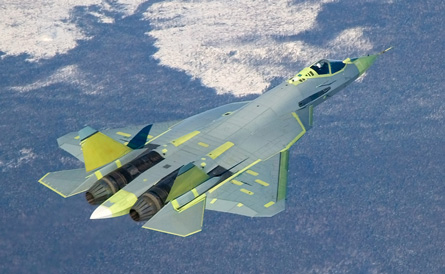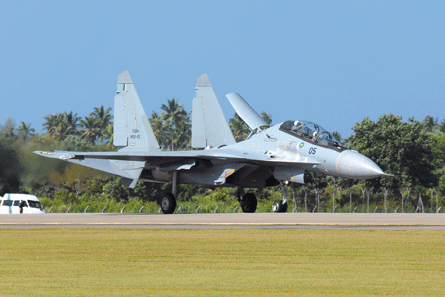Russia's air force and aviation industry is waiting to see what the much-heralded national rearmament programme promised by President Medvedev will yield in terms of firm aircraft orders.
After years of shrinking inventories and straitened budgets, there are hopes that new equipment will at last start to find its way to units. Announcements on new equipment are expected later this year.
There have been strong indications that heavy transport aircraft in the form of the Antonov An-124 and latest versions of the Ilyushin Il-76 will be among the early types to see new orders.
 |
|---|
© Sukhoi |
However, some of the keenest interest inside and outside Russia will be focused on the future of Sukhoi's fifth-generation PAK FA advanced tactical frontline fighter.
Alexey Fedorov, chairman of United Aircraft, the umbrella organisation that includes Sukhoi's military operations, says that the PAK FA remains in "preliminary flight test", confirming its predicted performance. So far, "the aircraft behaves as we expected".
Two further aircraft are due to join the flight-test programme to concentrate on onboard systems, including air-launched weaponry, with operational service due between 2015 and 2016.
The Russian air force requirement for the PAK FA is 250-300 aircraft, with India requiring roughly the same number under its Fifth Generation Fighter Aircraft programme, says Fedorov.
This aircraft would be a derivative of the PAK FA and "we are in negotiations with the Indian air force on specifications".
 |
|---|
© RSK MiG |
He declines to reveal further details, other than that service entry with India would probably be one to two years after the Russian air force receives its first examples.
India also holds the key to the continuation of another Russian design. The RSK MiG-35, the latest variant of the MiG-29 family, is one of six contenders squaring up for the biggest current prize in international fighter contracts, New Delhi's Medium Multi-Role Combat Aircraft contest for 126 aircraft.
India, whose air force and navy operate the MiG-29, would, until recently, have been considered to have a natural inclination towards Russian equipment.
However, the burgeoning Asian power has shown a new willingness in recent years to buy from the USA, in the form of Boeing P-8A Poseidon maritime patrol aircraft and Lockheed Martin C-130J Hercules transports.
Whether this amity will read across to the fighter contest is a moot point and Indo-Russian co-operation on the planned Ilyushin Il-214 multi-role transport aircraft, a twinjet type that would replace India's large fleet of Antonov An-32s, shows that the two nations retain closer than normal links in the technological and defence collaboration field.
If the MiG-35 does not land the Indian MMRCA contract, however, then the end of the road for the aircraft could be in sight.
 |
|---|
© Sukhoi |
The Sukhoi Su-30 family, meanwhile, has a more assured future, with India planning to double the size of its fleet to 230 aircraft by 2015, while Russian state arms exporter Rosoboronexport plans to offer additional Su-30s to meet a new Royal Malaysian Air Force fighter requirement. The service already has 18 of the type.
Russian news agency RIA Novosti reported in April that Rosoboronexport had concluded deals for 16 Su-30MKI(A)s with Algeria and for six Su-30MK2s with Uganda.
In the advanced trainer sector, Irkut president Oleg Demchenko holds out great hopes for the Yakovlev Yak-130 advanced jet trainer. In notable contrast to his cautious predictions on the civil side with the planned MS-21 airliner, he says he is genuinely optimistic the Yakovlev aircraft can take 50% of a market estimated at 2,500 aircraft.
The aircraft was designed as a successor to the Aero Vodochody L-29 and L-39, both of which remain in extensive service in Russia and overseas.
Reports of the numbers of Yak-130s sold have varied over the past couple of years, but according to Demchenko, the Russian air force has signed up for 72 out of a requirement for 250. The first four have been delivered and took part in this year's 9 May Victory Day flypast over Red Square and another eight are due to be delivered this year.
Algeria has ordered 16 (12 to be delivered this year) and Libya six (three due for delivery this year). Demchenko says that a major export order, for around 30, is expected before the end of the year.
Unsurprisingly, given the initial extensive design co-operation between Yakovlev and Aermacchi on the aircraft, he rates the Italian company's M-346 Master as a competitor, but believes several other types, both established and new, are less of a threat.
The BAE Systems Hawk is reaching the end of its production life, he argues, while Korea Aerospace Industries' supersonic T-50 Golden Eagle will appeal to a limited number of nations.
Source: Flight Daily News



















